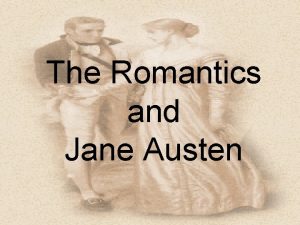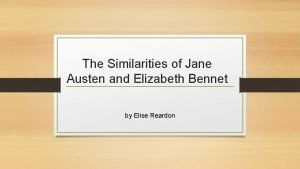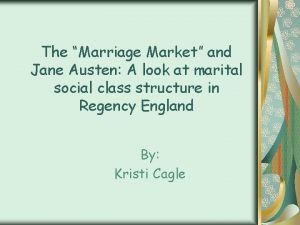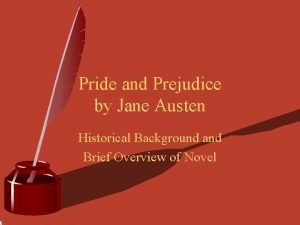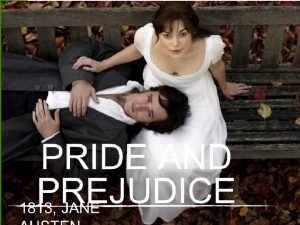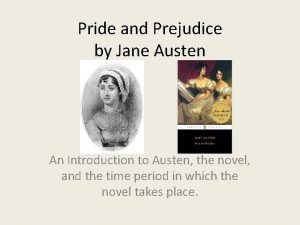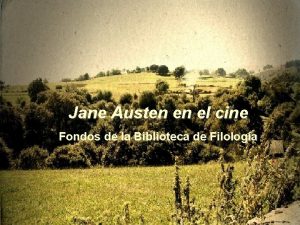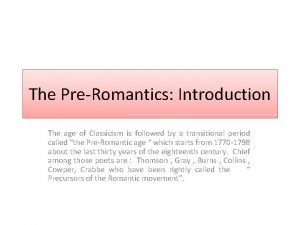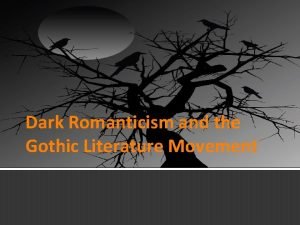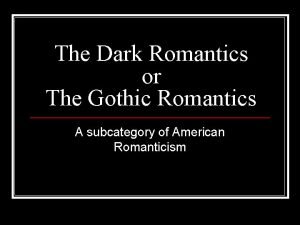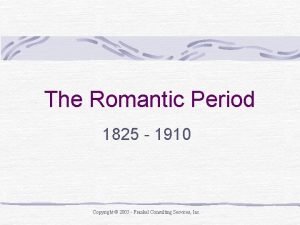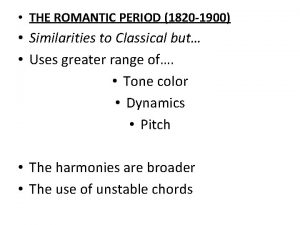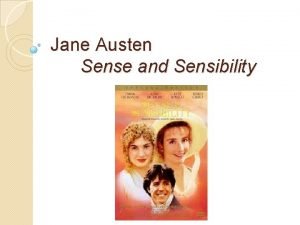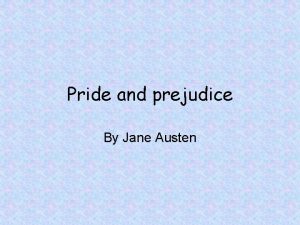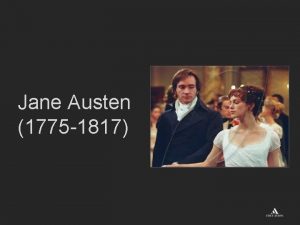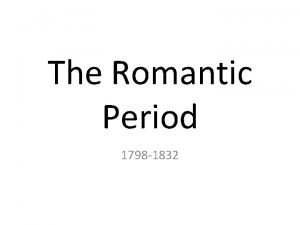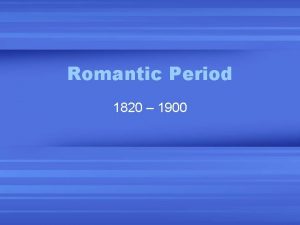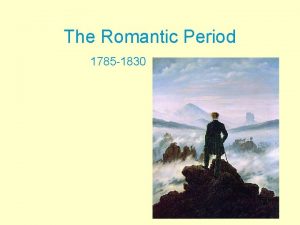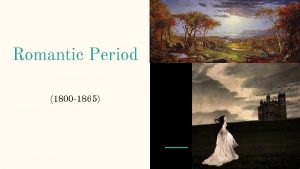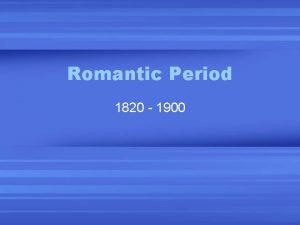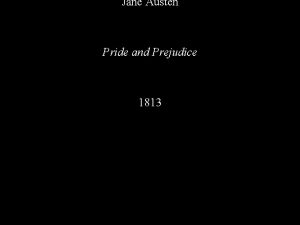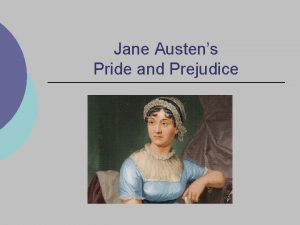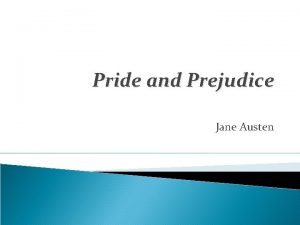The Romantics and Jane Austen The Romantic Period




















- Slides: 20

The Romantics and Jane Austen

The Romantic Period • 1798 - 1832 • Lyrical Ballads by William Wordsworth and Samuel Taylor Coleridge • Many revolutions in industry and agriculture

What Spurred the Romantic Period? – Idealized nature and human beings – Emphasized the individual, the personal, and the emotional – Sharp contrast to the science, logic, and reason of the Restoration – Was a movement of protest for more personal freedom and reform against conservative England

• Jean Jacques Rousseau - father of Romanticism, idea of the “noble savage” • 1832 - Reform Bill of 1832 – Marks the end of the Romantic period – More fairly distributed seats in Parliament and gave the vote to middle class men

What the Romantic Period is NOT… • Romantic period does NOT refer to love and romance • DOES refer to youth, innocence, questioning authority and tradition, adapting to change • Poets used common language and wrote about commonplace subjects, the beauty of nature, and the human imagination

The Six themes of Romantic Literature – Love of nature in all aspects – Concern and sympathy for the common man – Interest in the world of imagination, especially the supernatural – Rebellion against any form of tyrannical control – Interest in past legends, especially medieval and primitive – Involvement with the lonely and melancholic, especially with man’s eventual death

The Romantic Attitude Towards Poetry –Very emotional –Deals with personal feelings of the writer –Tends to be musical –Deals with nature –Imaginative –Helps us see things we otherwise would notice

The Poets… • 1 st generation poets -Wordsworth -Coleridge • 2 nd generation - radical political beliefs, selfimposed exile – Lord Byron – Percy Shelley – John Keats

The Novels and Novelists… • Gothic novels - mystery and horror – Mary Shelley - Frankenstein (1818) • Novels of Manners – Jane Austen’s Emma, Pride and Prejudice – Charlotte Bronte - Jane Eyre

The Language • Language - broadened the concept of “acceptable” English, narrowed the gap between aristocrats and commoners • American and British English grew further apart (spelling) – Publick – Colour – Splendour – Traffick – Flavour – Centre

Jane Austen: A visual journey through her novels, her life, and her countryside • Born December 16, 1775 • Died July 18, 1817 • She was the 7 th of 8 children • The youngest of two daughters • Born to a clergyman and his wife- George & Cassandra Austen • Her closest friend was her sister, Cassandra. “Jane” by Cassandra Austen

Her Childhood • Primarily educated at home • Benefited from her father’s extensive library • Led a quiet life at home • Was exposed to the outside world • Frank & Charles, her brothers St. Nicholas Church, Steventon -in the Royal Navy -traveled the world -served in the Napoleonic Wars The rectory where the family lived

• Attended Abbey Gatehouse School 1801 • Brother Henry becomes clergyman & moves to London - attended theatre, art exhibitions, & social events • Brother James becomes a banker • Brother Edward adopted by wealthy cousins and inherits an estate in Kent - Jane learns about the landed gentry at Godmersham - Knowledge that is reflected in her fiction The Abbey Gatehouse 1801, Reading

Possible settings for Jane’s novels… Godmersham Park The Ashe House The Ibthorp House Adelstrop

The Move to Bath… • Jane’s father retires • Jane and Cassandra move with their parents to Bath • Mr. Austen dies and Edward relocates the women to Chawton • All during this time, Jane is quietly writing, but publishes nothing • The move to Chawton changes that

Jane’s Time at Chawton Cottage • It is in this house that Jane submits her work for publication • At age 35, her most productive period begins • 1811 Sense & Sensibility is published • 1813 Pride & Prejudice is published • 1814 Mansfield Park is published • 1815 Emma is published

The Beginning of the End… • In 1815, Jane begins Persuasion and finishes it the following year • Her health begins to fail as a result of probable Addison’s Disease • In March of 1817, Jane and Cassandra move to Winchester to be nearer to Jane’s doctor • Jane dies in the early morning hours of July 18, 1817 • Persuasion and Northanger Abbey were published the following December

Jane’s Burial Place Winchester Cathedral

Quill and Ink

The Regency Style of Dress Spencer Jacket & Bonnet Jane’s Pellise 1780’s Silk Dress
 Jane austen and romanticism
Jane austen and romanticism Similarities between jane austen and elizabeth bennet
Similarities between jane austen and elizabeth bennet This passage is adapted from jane austen
This passage is adapted from jane austen Marriage market jane austen
Marriage market jane austen Historical background of pride and prejudice
Historical background of pride and prejudice Performer heritage soluzioni
Performer heritage soluzioni Pride and prejudice introduction
Pride and prejudice introduction Jane austen
Jane austen 1750 1825
1750 1825 Pre romantic age poets
Pre romantic age poets Dark romanticism vs gothic
Dark romanticism vs gothic Gothic dark romanticism art
Gothic dark romanticism art Dark romanticism beliefs
Dark romanticism beliefs Period of activism in philippine literature
Period of activism in philippine literature Romantic period in american literature
Romantic period in american literature How is romanticism different from neoclassicism
How is romanticism different from neoclassicism Austenblake
Austenblake Wagner romanticism
Wagner romanticism Characteristic of romantic period
Characteristic of romantic period Characteristic of the romantic period
Characteristic of the romantic period The era of change 1798-1832
The era of change 1798-1832
